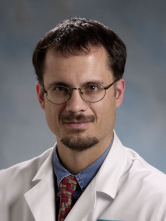Adjuvant Imatinib Opinions
The term adjuvant therapy refers to the use of imatinib (Gleevec) after surgical resection of a primary gastrointestinal stromal tumor (GIST) in order to prevent recurrence or metastasis. Several ongoing clinical trials are testing different durations of adjuvant imatinib in GIST, but only preliminary results are available so far. Current results are summarized at this page. Before these trials results are fully known, patients and physicians need to make current decisions regarding which patients may benefit from adjuvant imatinib.
GIST Support International posed questions about adjuvant therapy for GIST to two experts who discussed this topic at the Novartis New Horizons meeting in early 2009: Professor Jean-Yves Blay, MD PhD and Jon Trent II, MD PhD.
 Dr. Blay is Professor of Medical Oncology (1st class) at University Claude Bernard in Lyon, France, as well as Head of the Medical Oncology Department in Centre Léon Bérard Cancer Center. He was Chairman of the Soft Tissue and Bone Sarcoma Group of EORTC in 2005-2008 and now serves as President of EORTC (European Organization for Research and Treatment of Cancer). Among numerous cancer professional associations in which he is active, Professor Blay has served on the Board of the Connective Tissue Oncology Society (CTOS). He is Chairman of the French Sarcoma Group, and the Network Director of Conticanet (conticanet.eu). His publications include numerous GIST investigations as well as studies involving other sarcomas and other cancers. Professor Blay is quite active in clinical trials for new drugs.
Dr. Blay is Professor of Medical Oncology (1st class) at University Claude Bernard in Lyon, France, as well as Head of the Medical Oncology Department in Centre Léon Bérard Cancer Center. He was Chairman of the Soft Tissue and Bone Sarcoma Group of EORTC in 2005-2008 and now serves as President of EORTC (European Organization for Research and Treatment of Cancer). Among numerous cancer professional associations in which he is active, Professor Blay has served on the Board of the Connective Tissue Oncology Society (CTOS). He is Chairman of the French Sarcoma Group, and the Network Director of Conticanet (conticanet.eu). His publications include numerous GIST investigations as well as studies involving other sarcomas and other cancers. Professor Blay is quite active in clinical trials for new drugs.
 Dr. Trent is an Associate Professor in the Department of Sarcoma Medical Oncology at M.D. Anderson Cancer Center in Houston, Texas. His awards include the 2002 Young Investigator Award from the Connective Tissue Oncology Society (CTOS) and the 2002 Award for Excellence in Research from the M. D. Anderson Cancer Center’s Division of Cancer Medicine. Dr. Trent has published extensively about GIST and other sarcomas and is quite active in clinical trials.
Dr. Trent is an Associate Professor in the Department of Sarcoma Medical Oncology at M.D. Anderson Cancer Center in Houston, Texas. His awards include the 2002 Young Investigator Award from the Connective Tissue Oncology Society (CTOS) and the 2002 Award for Excellence in Research from the M. D. Anderson Cancer Center’s Division of Cancer Medicine. Dr. Trent has published extensively about GIST and other sarcomas and is quite active in clinical trials.
Below are the two experts’ responses to our questions.
1. What is the percent risk of recurrence (as defined by the Miettinen and Lasota table endorsed by the NCCN task force on GIST) above which you would recommend adjuvant imatinib therapy to a patient, or does that depend on the patient’s own risk acceptance level?
Dr. Blay: I think it depends mainly on patient’s own risk acceptance level, BUT I would recommend the treatment for risks >50% and would not recommend for risks <20%.
Dr. Trent: “Estimated percent risk of recurrence” is only one piece of the clinical decision-making puzzle. As indicated by Dr. Blay, the other major piece is the patient’s level of risk acceptance. Additionally, one might consider patient age, mutation status, current quality of life, other diseases, quality and quantity of tissue used to measure mitotic rate, and surgical findings (whether it was multifocal, whether there was possible tumor rupture), or positive margins).
2. How long do you recommend for a patient to take adjuvant therapy, and does the length of time you recommend depend on the level of risk?
Dr. Blay: At least one year, maybe 3 years depending on the SSG trial
Dr. Trent: I generally treat patients for at least 2 years. The publication by McAuliffe et al (Annals of Surgical Oncology 2009) evaluated adjuvant imatinib at a 2-year duration. This study found that after 2 years of adjuvant imatinib 87% of patients were recurrence free compared to 83% of patients at 2 years after 1 year of adjuvant therapy (Z9001 study). Additionally, this study found that 100% of patients that completed 2 years of adjuvant imatinib were recurrence-free at 2 years. However, ongoing studies mentioned by Dr. Blay may help determine whether there is an advantage to 3 years or 5 years of adjuvant imatinib. If there is a high risk for pre-existing microscopic metastases, ie tumor rupture, then I treat for lifelong.
3. What dose of imatinib would you recommend as adjuvant therapy for an exon 9 patient?
Dr. Blay:I discuss that with the patient. 800mg/d would be recommended in principle, BUT WE HAVE NO DATA. So, 400 mg/day unless the Z9001 and EORTC 62024 shows that the risk of relapse is not affected by adjuvant treatment
Dr. Trent: There is currently a lack of data in the adjuvant use of high-dose imatinib. The data supporting high-dose imatinib in the metastatic setting is sufficient for one to consider the highest adjuvant dose of imatinib that a patient can tolerate up to 800 mg/day.
4. Are there any mutation types for which you would NOT recommend adjuvant therapy (such as wildtype or exon 18 D842V)?
Dr. Blay: NO.
Dr. Trent: I agree. Patients with wild-type GIST can benefit from imatinib.
5. Would you consider changing the dose of Gleevec used for adjuvant therapy if plasma level testing showed a low level of Gleevec in circulation, or a high level in a patient burdened by severe side effects?
Dr. Blay: NO. (This is a topic for a study.)
Dr. Trent: If a patient is burdened by severe side-effects not alleviated by supportive measures then one should consider reducing the dose independent of the plasma level. A very high plasma level may reassure a patient that reducing from 400mg daily to 300mg daily, which is standard practice. Escalating the dose of imatinib based on low plasma levels is the subject of a planned study.
6. What are the important unanswered questions about adjuvant imatinib that ongoing trials may answer?
Dr. Blay: Does it improve overall survival?
Dr. Trent: I agree with Dr. Blay. However, I am concerned that the ongoing clinical trials may not give us a clear answer as to whether adjuvant imatinib improves survival. We will continue to use adjuvant imatinib based on the surrogate of progression-free survival. The ongoing trials may shed light on the duration of imatinib therapy. The ongoing trials may refine the risk assessment as data emerges on type of mutation (including wild-type), mitotic rate, and site of primary disease. Q
7. Can you speculate whether there will be a duration (longer than 1 year) that will be “enough” for adjuvant therapy, or might it require the addition of another drug together with imatinib to actually kill quiescent GIST cells to make adjuvant therapy potentially curative?
Dr. Blay: This is only speculation: I would say, lifelong.
Dr. Trent: Another drug to enhance the cytotoxicity of imatinib or a more effective imatinib would be very welcome.

